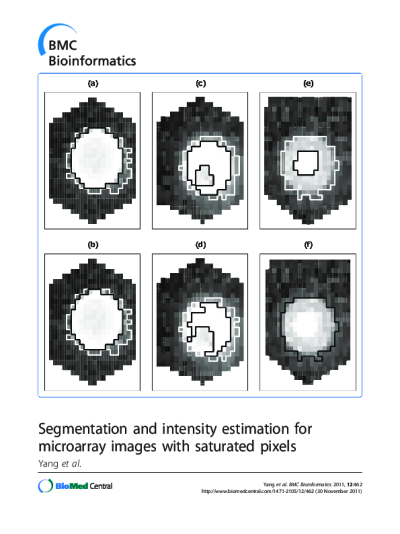Segmentation and Intensity Estimation for Microarray Images With Saturated Pixels

Background: Microarray image analysis processes scanned digital images of hybridized arrays to produce the input spot-level data for downstream analysis, so it can have a potentially large impact on those and subsequent analysis. Signal saturation is an optical effect that occurs when some pixel values for highly expressed genes or peptides exceed the upper detection threshold of the scanner software (216 - 1 = 65, 535 for 16-bit images). In practice, spots with a sizable number of saturated pixels are often flagged and discarded. Alternatively, the saturated values are used without adjustments for estimating spot intensities. The resulting expression data tend to be biased downwards and can distort high-level analysis that relies on these data. Hence, it is crucial to effectively correct for signal saturation.
Results: We developed a flexible mixture model-based segmentation and spot intensity estimation procedure that accounts for saturated pixels by incorporating a censored component in the mixture model. As demonstrated with biological data and simulation, our method extends the dynamic range of expression data beyond the saturation threshold and is effective in correcting saturation-induced bias when the lost information is not tremendous. We further illustrate the impact of image processing on downstream classification, showing that the proposed method can increase diagnostic accuracy using data from a lymphoma cancer diagnosis study.
Conclusions: The presented method adjusts for signal saturation at the segmentation stage that identifies a pixel as part of the foreground, background or other. The cluster membership of a pixel can be altered versus treating saturated values as truly observed. Thus, the resulting spot intensity estimates may be more accurate than those obtained from existing methods that correct for saturation based on already segmented data. As a model-based segmentation method, our procedure is able to identify inner holes, fuzzy edges and blank spots that are common in microarray images. The approach is independent of microarray platform and applicable to both single- and dual-channel microarrays.
- Author (aut): Yang, Yan
- Author (aut): Stafford, Phillip
- Author (aut): Kim, YoonJoo
- Contributor (ctb): College of Liberal Arts and Sciences


